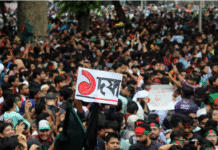Sushovan Dhar
Jeeban Puri from Sindhupalchowk district in Nepal, while working as a driver in Damam, Saudi Arabia, wanted to get back home desperately after the recent 7.8-magnitude earthquake which struck Nepal. Reaching his place, he discovered that his three-year-old son had died and his house was totally destroyed.
Only 10 months into his job, he carried a debt of Rs150,000 ($1,500) which was paid to a broker who arranged it. Puri, who borrowed this amount at 36% interest, is now badly trapped. He needs to spend time in Nepal to look after his family and rebuild a shelter, but the length of his stay would also lengthen the debt burden. His salary of $250 a month is insufficient to see off the loan as most of his income is exhausted on his family’s basic needs.
Not only in Nepal but in many impoverished parts of Asia, Africa, and Latin America, agents demand large amounts of money from aspirant migrants, forcing desperate men from these regions to take loans with outrageous interest rates to meet the demands. The limited scope of legally-authorised migration, increasing restrictive immigration policies, and tighter border controls by receiving countries make it a lucrative market for migration services flourish. The expanded and wide-ranging fees for their services are frequently very high. This leads to hapless migrants getting entangled in different forms of debt to a variety of parties.
Debt imposes conditions
Such indebtedness may not essentially be to the agents providing migration services. The agents mostly insist upon payment once the journey has been made. This results in a patchwork of loans from money-lenders or other agencies at home or abroad that migrants resort to in order to obtain the huge amounts required to pay for their passage and a job.
It is not an exception that savage means are often used to force their families at home into paying off, throwing migrants under immense pressure to repay the debts by any means possible. In a number of cases, large debts can make migrants defenceless against forced labour in destination countries.
Last November, the brutal murder of two Indonesian migrant workers in Hong Kong invited a lot of reaction. More so because the two victims, Sumarti Ningsih and Seneng Mujasih, were sex workers and both of them had landed at Hong Kong as domestic workers. But after losing her job, Mujasih overstayed her visa and resorted to the sex trade since she hadn’t been able to pay her agency fees. Steep recruitment fees are, in numerous occasions, responsible for pushing women towards prostitution.
According to Hong Kong-based NGO Asia Pacific Mission for Migrants, huge amounts are collected in the name of placement and training. Such fees range from 31,000-37,000 Hong Kong dollars while the wage is around 4,110 Hong Kong dollars ($530). Often, they have to pay their whole salaries to service the debt, leaving them with nothing to survive yet compelled to borrow more and landing permanently in a vicious debt-cycle.
This debt-cycle intemperately curtails people’s chances to fend for themselves and, in addition to the anxiety of losing their freedom and being deported, creates conditions in which they dragged into highly exploitative, often lurid, employment relations and extremely pitiable working conditions. The situation for migrant workers, especially in the Gulf countries, is often miserable. Many are forced to take on hazardous work in terrible heat.
Till date, more than 400 migrant workers, mostly Nepalese, have perished on Qatar’s building sites since the country won its bid to host the FIFA World Cup 2022, prompting demands of shifting the competition somewhere else.
The Kafala system, a sponsorship procedure used to regulate migrant workers in Qatar and the Gulf countries, confines workers to single employers who sponsor their visas. This infamous practice bestows extensive powers to the employer and imposes massive restrictions on migrant workers.
There are extensive reports of coercion, abuses, exploitation, and other mistreatments by sponsors using this legal system. Stories of torture, rape, and murder are also common. This widely condemned system is akin to modern slavery. However, many migrants in other regions and countries face similar conditions as immigration laws and regulations tie them to specific jobs with specific employers.
These regulations secure the temporal transience and spatial fixation of the migrant workers and hinders their free movement in the “free” labour market to which they belong, in theory. Though such workers are not legally bound to the individual employer, in reality they have very limited mobility and are treated like bound-labourers.
Amran from Bangladesh wanted to escape the drudgery of unemployment back home and longed to work abroad. This 23-year-old borrowed money, at high interests, from wherever he could, managing the $7,000 needed to pay a local Bangladeshi agent to obtain employment as a construction worker in Singapore.
Only nine months into his job in concrete assembly, Amran fell and broke his leg so severely that his bones popped out through his skin. In spite of doctor’s advice to keep him in the hospital for further medical care and treatment, his employer sent him back to the worker’s dormitory barely a week later, with a metal plate and 60 screws inserted into his leg.
Left to fend for himself with a supply of pills and food supplied by friends, he’s eventually healed but left with a permanent disability and a large debt. He currently finds himself unemployable. Singapore, a model for stability and business-friendliness, employs around a million foreign workers to keep its economy running, especially in its booming construction sector and shipyard operations. However, when it comes to worker-friendliness, numerous stories similar to Amran’s suggest something terrible.
Debt-trap and exploitation
Labour migration and the associated debt-trap leads to grievous restriction on workers’ freedoms, fixing them into immensely asymmetrical relations of power and dependence. A careful scrutiny would suggest that countries dependent on migrant workers frame immigration policies in such a manner that the latter is deprived of independent access to the labour market or any mobility within.
They are often given short-term work permits, and a range of additional restrictions on their rights and freedoms are imposed, depending on the country, and on the particular type of work permit they are issued. They are sometimes legally prohibited from joining trades unions, and deliberately left out of labour legislations and safeguards that exist for other workers.
Such conditions create extremely coercive forms of exploitation. On the other hand, it might take months, or even years, for a number of ordinary migrant workers, especially manual workers, to repay debts incurred in order to migrate. Regrettably, during this time, they are most likely to experience violence and physical confinement, as well as severe labour exploitation due to their indebtedness and other liabilities.
Sadly enough, many countries in the south which depend on migrant remittances to cover their balance of payments and propel their economy, lack the requisite pro-activity to safeguard the citizens. Thus, migrant workers, caught in a vicious cycle of debt and abominably exploitative working conditions, do not have anyone to look out for them and are condemned to such inhumane conditions for the rest of their existence.
Source: Dhaka Tribune










